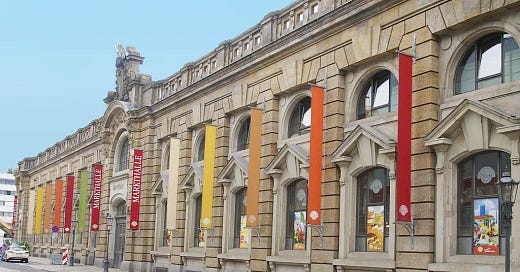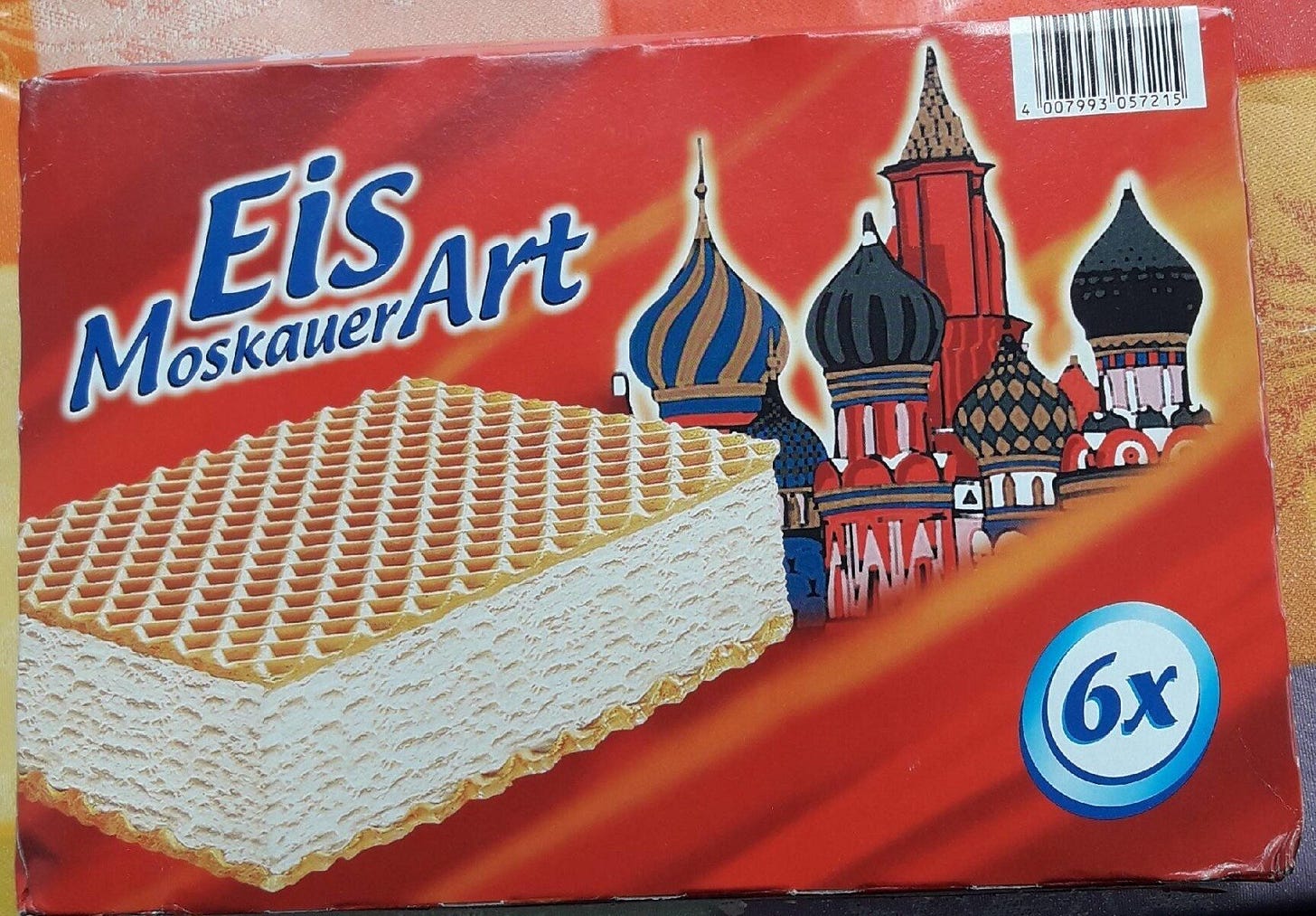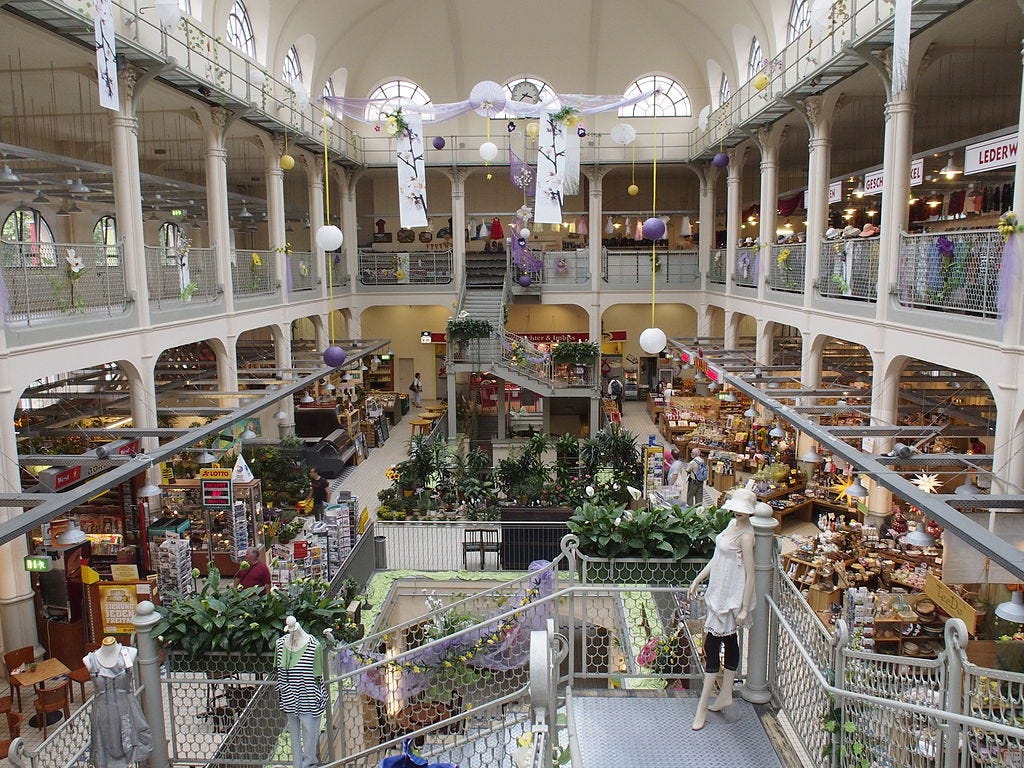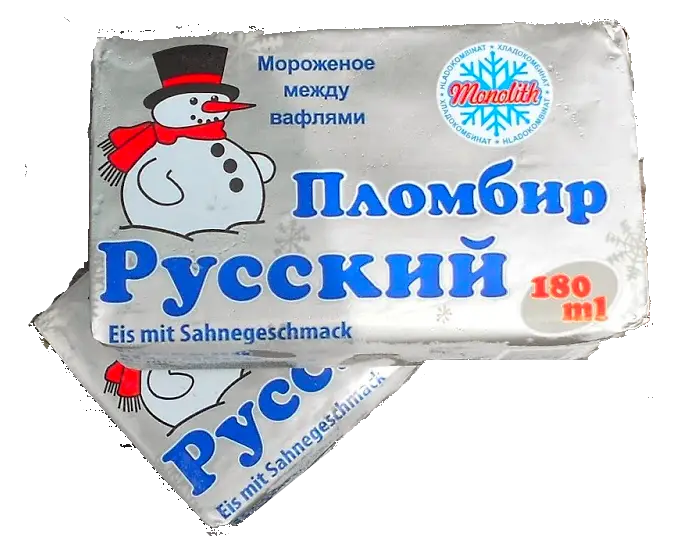Moskauer Art' ice cream: cream, wafers and cold war.
Born in the Soviet Union, it became an Eastern European tradition and, until recently, a cake of nostalgia. Today, it is also the stuff of the new Cold War.
If you are a child of Mitteleuropa and over forty years old, you know it: the ice cream sandwich made the Moscow way. When I ate it as a child on holiday in Grado (our little Italian Mitteleuropa), I didn't know I was enjoying a Russian speciality. We improperly called it 'spumone'; it took decades for me to discover that it was a classic spread from Gdansk to Leipzig, from Prague to St Petersburg, and that this classic has Soviet origins.
I can still find it on the shelves of Berlin supermarkets today, even if relegated to the bottom of the freezer cabinet: a creamy ice cream, with an amount of fat beyond all dietary limits, that withstood the Cold War and has come down to us. At least, until the Russian invasion of Ukraine.
Eis Moskauer Art, ice cream the Moscow way.
Describing it all is easy: a brick of cream ice cream made with whole milk held together by two thin wafers. That's all it is: almost two hundred grams of cream in ice-cream form. Warning: it can be addictive (in my case, only softeis, another speciality from the East, has a stronger pull).
The history of 'Moskauer Art' ice cream begins - to be exact - in Moscow in 1938, when mass production began. These were the years of the 'Great Terror', the terrible Stalinist purges, but also the attempt to provide the masses with good products that could compete with the capitalist world, or even be better. In the case of Moscow ice cream, the use of preservatives was totally forbidden: the preparation was meticulously controlled and the purity standards to be observed were strict.
From here, after the Second World War, ice cream spread throughout the Soviet bloc. In the GDR, 'Moscow-style' cream ice cream was considered a speciality and cost more than the others: one Mark-DDR for an ice cream. Today, it belongs to the ranks of those 'retro' products: those who look for the six-portion box in the supermarket, which can be found in almost all supermarkets in the eastern GDR and also in discount stores, are usually either born here or, like me, are 'children of the border'.
In Dresden: eat the original Moscow and feel like ambassadors of peace.
I still missed its original 'made in the USSR' version. Finding it in Dresden and consuming it by chance in an old covered market turned into an opportunity to talk about Russophobia and reflect on how damnatio memoriae, applied to food, is crazy bullshit.
Wandering around Dresden on an August afternoon, off the most popular tourist routes, we arrive in the centre of the Neustadt, on the opposite side of the Elbe from the old city dominated by the Fraunkirche and the beautiful Baroque palaces.
Behind a large avenue, we see one of those old covered markets that everywhere in Europe - from Paris to London, Berlin and Barcelona - have been renovated and brought to new splendour, mixing their original function - hosting local or exotic food shops - with new small tasting rooms to pass the time in company. We enter.
Flooded with light, with wrought-iron railings, ornate iron staircases and striking Wilhelmine lanterns, the covered market at Antonplatz (Neustadt Markthalle) is a little gem from the late 19th century. I discover, again with historic delay, that I am in one of the most beautiful historic markets in Germany. The year of its opening, 1899, belongs to the era in Germany known as the 'Gründerzeit' (lit. founders' age), i.e. the first years after the foundation of the German empire and the heart of the industrial revolution, which here in Dresden and Saxony was a golden age.
It is one of my travel companions who points out the shop selling Russian products, attracted not by the food but by a set of teacups celebrating the ZAZ brand, the famous Soviet car built in Saporischja (or Saporoschje in Russian, a place we all know from the news). Few Western Europeans know about the ZAZ these days - the enthusiasts of European motoring history or those who, like me, had a ZAZ in the family. But that's another story...
In short, we have entered the time machine: the shop run by Mrs Olga Kebernik becomes one of the highlights of our days in Dresden. I focus on the bottles of Vodka, the motoring enthusiast on the Soviet motoring devotionals and the third opens a freezer that turns out to be a treasure trove of confectionery wonders: out of it sprout beautiful bricks written in Cyrillic, the original Eis Moskauer Art.
It is an almost Proustian moment, but less intimate: together we discover that, with different labels and names, we all know that ice cream and have different stories to tell about it. And, inevitably, we also have questions for Mrs Olga.
The shop owner has been there for some time, and has had better times than now, with a varied clientele: the Russian-German community in Dresden, added to the residents of Russian nationality, amounts to more than seven thousand people and almost all of them have passed through here; then, many 'Ostalgic' Germans and some tourists. Until two years ago, also groups of pro-Putinites, attracted by the fact that Olga was selling several Putin-type devotionals: t-shirts, calendars, matryoshkas, stuff like that.
Then the pandemic, and finally the war: since February 2022, the Putin T-shirts have disappeared and food and alcohol have remained, plus a few handicrafts and souvenirs such as ZaZ car mugs. Above all, many customers have disappeared. There was no lack of insults on Google, shouted insults in the middle of the market, and pro-Ukrainian demonstrations calling for a boycott of the shop. Now, however, the situation is calmer. Power of habituation.
We won't get into the conversation: we don't want to offend anyone's sensibilities. After our visit, poking around on the Internet, we find out from the website of one of the local newspapers that Mrs Olga grew up in Crimea and is proud to be Russian. Convinced, of course, that Crimea can only depend on Moscow.
Never wage war on food, not even with words. Least of all with marketing.
The cereals, the naval blockade, and the 'Ukraine' granary, much desired even by Nazi Germany. No, it is better not to go into this tangled secular history. But on one thing we can agree, each with his own experiences: food unites, not divides. Food should never be used for war, propaganda or to send political messages.
Even our 'Eis moskauer Art' ice cream fell victim to the zeal of those who always want to 'send a message': a bit like streets being renamed, stuccoes and statues removed, the ice cream brick also fell victim to damnatio memoriae.
The renaming frenzy begins in March 2022 in the Czech Republic, where Moscow-style ice cream is still a bestseller, from city kiosks to motorway service stations: you can find it everywhere, even more so than in East Germany. Here, one of the largest local producers has renamed it 'Ukrainian ice cream', Ukrainer Eis. The haste to change the name of the ice cream was such that even an ex post label was applied to the ice creams already produced, to cover the original name.
In July 2022, Edeka, Germany's largest retail supermarket chain, takes over. Their 'Gut und Günstig' (Good and Convenient) ice cream, sold under the name 'Ice Sandwich Moskauer Art' is renamed (temporarily) to 'Kiewer Art'.
But criticism came from all sides, especially on Twitter. Not from pro-Moscow groups, but from people who find the initiative excessive, misplaced and even poorly executed. Respect would involve, for example, spelling Kyiv (as the Ukrainian language dictates) and not Kiev (in the Russian way).
And then there is the historical point. If the brick of cream originally came from Moscow, it came from there, not from Mars. Do we want to erase Moscow from the atlases? Do we want to remove the name Moscow from every place where it is used, like the Café Moskau on Karl-Marx-Allee in Berlin, which for some time was given the new (also temporary) name Café Kyiv?
There are enough people busy writing, rewriting and rewriting history: let's leave the stories and names of sweets, ice creams and cafes.
Epilogue.
Now Edeka's ice cream is just called 'Ice Snack Sandwich'... goodbye Moscow, at least for now.
Subscribe to Beyond Berlin for more stories like this, and to share your own.
If the post has inspired you, share it with others: sharing is caring!










